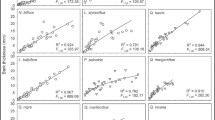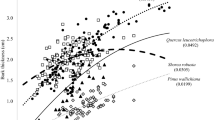Abstract
Key message
Bark allocation patterns did not follow fire-tolerance grouping of tree species in all cases; more studies are needed on bark development from juvenile to adult trees.
Abstract
Thick bark is presumed to be a trait of fire-tolerant trees that were historically subjected to frequent surface fires. To be recruited into the forest canopy, a tree must be able to survive fire and grow thick enough bark during the fire-free interval. Previous studies have also suggested that fire-tolerant species grow disproportionately thick bark lower on the stem, where the threat of fire is greatest. The objectives of this study were to quantify how bark develops in six juvenile hardwood species of the Appalachian Piedmont and compare bark allocation between fire-tolerant (Carya tomentosa, Quercus alba, and Quercus velutina) and mesophytic species (Acer rubrum, Fagus grandifolia, and Liriodendron tulipifera). We sampled up to 32 individuals of each species and modeled bark area as a function of wood area and measure height using mixed effect models. Bark area increased approximately 0.4 cm2 for Q. velutina and C. tomentosa, 0.2 cm2, for L. tulipifera and Q. alba, and 0.1 cm2 for A. rubrum and F. grandifolia for each cm2 increase in wood area, holding measure height constant. For Q. velutina, C. tomentosa, and L. tulipifera, the measure height was found to decrease bark area by approximately 0.02, 0.01, and 0.01 cm2 for each cm increase in height, holding diameter constant. A paired sample Wilcoxon test comparing bark:wood ratio at 0 and 140 cm heights yielded similar results. Differences in bark allocation among the six species were not consistent with current groupings of “fire-tolerant” and “mesophytic” species.

Similar content being viewed by others
References
Abrams MD (1992) Fire and the development of oak forests. BioScience 42:346–353
Barton K (2016) MuMIn: multi-model inference. R package version 1.15.6
Bates D, Maechler M, Bolker B, Walker S (2015) Fitting linear mixed-effects models using lme4. J Stat Softw 67:1–48
Brose PH, Van Lear DH (1998) Responses of hardwood advance regeneration to seasonal prescribed fires in oak-dominated shelterwood stands. Can J For Res 28:331–339
Brose PH, Schuler TM, Van Lear DH, Berst J (2001) Bringing fire back: the changing regimes of the Appalachian mixed-oak forests. J For 99:30–35
Brose PH, Schuler TM, Ward JS (2006) Responses of oak and other hardwood regeneration to prescribed fire: what we know as of 2005. In: Dickenson MB (ed.) 2006. Fire in eastern oak forests: delivering science to land managers, proceedings of a conference; 2005 November 15–17; Columbus, OH. Gen. Tech. Rep. NRS-P-1. Newtown Square, PA: U.S. Department of Agriculture, Forest Service, Northern Research Station: 123–135
Carey JH (1992) Quercus velutina. In: Fire effects information system, [Online]. US Department of Agriculture, Forest Service, Rocky Mountain Research Station, Fire Sciences Laboratory (Producer). http://www.fs.fed.us/database/feis/. Accessed 1 Oct 2016
Coladonato M (1992) Carya tomentosa. In: Fire effects information system, [Online]. US Department of Agriculture, Forest Service, Rocky Mountain Research Station, Fire Sciences Laboratory (Producer). http://www.fs.fed.us/database/ feis/. Accessed 1 Oct 2016
Elliott KJ, Hendrick RL, Major AE, Vose JM, Swank WT (1999) Vegetation dynamics after a prescribed fire in the southern Appalachians. For Ecol Manage 114:199–213
Frost CC (1998) Presettlement fire frequency regimes of the United States: a first approximation. In: Pruden TL, Brennan LA (eds) Fire in ecosystem management: shifting the paradigm from suppression to prescription, pp 70–81
Graves SJ, Rifai SW, Putz FE (2014) Outer bark thickness decreases more with height on stems of fire-resistant than fire-sensitive Floridian oaks (Quercus spp.; Fagaceae). Am J Bot 101:2183–2188
Hammond DH, Varner JM, Kush JS, Fan Z (2015) Contrasting sapling bark allocation of five southeastern USA hardwood tree species in a fire prone ecosystem. Ecosphere 6:1–13
Hare RC (1965) Contribution of bark to fire resistance of southern trees. J For 63:248–251
Hurvich CM, Tsai CL (1989) Regression and time series model selection in small samples. Biometrika 76:297–307
Jackson JF, Adams DC, Jackson UB (1999) Allometry of constitutive defense: a model and a comparative test with tree bark and fire regime. Am Nat 153:614–632
Kreye JK, Varner JM, Hiers JK, Mola J (2013) Toward a mechanism for eastern North American forest mesophication: differential litter drying across 17 species. Ecol App 23:1976–1986
Midgley JJ, Lawes MJ (2016) Relative bark thickness: towards standardised measurement and analysis. Plant Ecol 217:677–681
Nowacki GJ, Abrams MD (2008) The demise of fire and “mesophication” of forests in the eastern United States. Bioscience 58:123–138
Odhiambo B, Meincken M, Seifert T (2014) The protective role of bark against fire damage: a comparative study on selected introduced and indigenous tree species in the Western Cape, South Africa. Trees 28:555–565
Pausas JG (2015) Bark thickness and fire regime. Func Ecology 29:315–327
R Core Team (2016) R: A language and environment for statistical computing. R Foundation for Statistical Computing, Vienna, Austria. https://www.R-project.org/. Accessed 1 Oct 2016
Sander IL (1990) Quercus velutina Lam. (Black oak). In: Burns RM. Honkala BH, technical coordinators. Silvics of North America. Vol. 2. Hardwoods. Agricultural Handbook 654. https://www.na.fs.fed.us/spfo/pubs/silvics_manual/volume_2/quercus/velutina.htm. Accessed 1 Oct 2016
Schwilk DW, Gaetani MS, Poulos HM (2013) Oak bark allometry and fire survival strategies in the Chihuahuan Desert Sky Islands, Texas, USA. PLoS ONE 8:e79285
Smith HC (1990) Carya tomentosa (Poir.) Nutt. (Mockernut hickory). In: Burns RM, Honkala BH, technical coordinators. Silvics of North America. Vol. 2. Hardwoods. Agricultural Handbook 654. https://www.na.fs.fed.us/spfo/pubs/silvics_manual/volume_2/carya/tomentosa.htm. Accessed 1 Oct 2016
Tirmenstein DA (1991) Quercus alba. In: Fire effects information system, [Online]. US Department of Agriculture, Forest Service, Rocky Mountain Research Station, Fire Sciences Laboratory (Producer). http://www.fs.fed.us/database/ feis/. Accessed 1 Oct 2016
USDA-NRCS (2015) Natural resources conservation service, United States Department of Agriculture. Web Soil Survey. http://websoilsurvey.nrcs.usda.gov/. Accessed 1 Oct 2016
Van Lear DH, Waldrop TA (1989) History, uses, and effects of fire in the Appalachians. USDA Forest Service Gen. Tech. Rep. SE-54
Varner JM, Kane JM, Hiers JK, Kreye JK, Veldman JW (2016) Suites of fire-adapted traites of oaks in the southeastern USA: multiple strategies for persistence. Fire Ecol 12:48–64
Acknowledgements
This study was partially funded by the Clemson Foundation. We thank Bridget Blood for reviewing an early version of this manuscript. We also thank the two anonymous reviewers, whose comments greatly improved the manuscript.
Author information
Authors and Affiliations
Corresponding author
Ethics declarations
Conflict of interest
The authors declare that they have no conflict of interest.
Additional information
Communicated by Y. Sano.
Electronic supplementary material
Below is the link to the electronic supplementary material.
Rights and permissions
About this article
Cite this article
Shearman, T.M., Wang, G.G., Ma, P.T. et al. Patterns of bark growth for juvenile trees of six common hardwood species in the eastern United States and the implications to fire-tolerance. Trees 32, 519–524 (2018). https://doi.org/10.1007/s00468-017-1649-9
Received:
Accepted:
Published:
Issue Date:
DOI: https://doi.org/10.1007/s00468-017-1649-9




